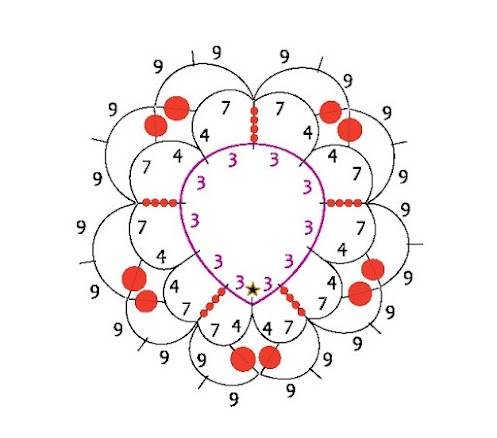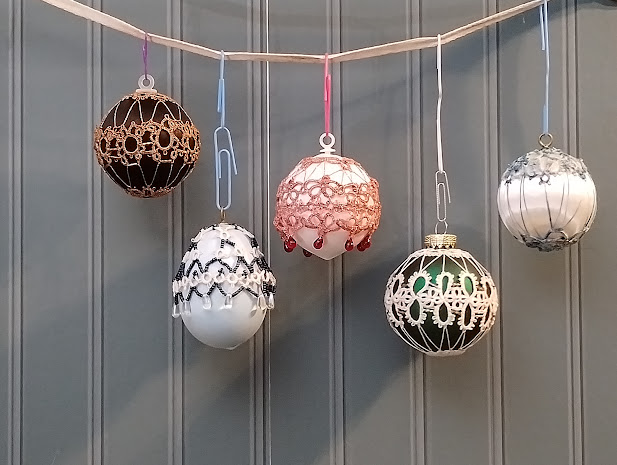During the past 6 or 7 months, we have been waiting for our new home to be ready for us to move into, there has been some time for reflection about some of the artistic pursuits I enjoy. These include knitting, crochet, tatting, sewing, papercrafting, rosemalling (traditional Norwegian painting) and watercolor. With such an extensive list, it's fair to state that I am not necessarily a master of any of these, although I have been active in many of these since childhood.
As a tatter, I applied to a local Fine Arts League to enter one of their juried shows while also entering the local area fair's heritage techniques competition. Twice I was awarded a red ribbon for my entry at the Mountain State Fair, but the Fine Arts League refused to allow my entry to their competition. Upon asking for an expanation of the rational for declining my entry to such an organization, I was told that quilting is an art form, but tatting is not. This seemed odd to me so an investigation of Art compared to Craft seemed appropriate.
Not the highest level of researcher, I turned to the internet and found 2 sources that were intriguing:
https://artincontext.org/difference-between-art-and-craft/
and a video entitled "How Folk Art Shaped the World We Know Today"
What I am going to share comes from these sources and others as well. Art historians H. W. Janson and A. F. Janson open their 1000 page "History of Art" by asking "What makes this Art?" And this is indeed the quintessential question. Mankind has been expressing himself by way of a variety of vehicles that are lumped together as "Art." From painting, to sculpture, to carving objects out of wood, stone and bone, forming vessels from clay and turning animal hair (or human hair for that matter) into wearable clothing of unique style. There is also photography, choreography, drama, music, creative uses of paper (oragami, for example) or even the making of paper itself; the list seems endless. And still the question remains: "What makes any given endeavor Art?" And what keeps tatting from being Art?
In the article "Difference Between Art and Craft - A Look at Art Versus Craft," Isabella Meyer wrote that the division between crafts and arts began during the Renaissance Period. Beginning at the end of Medieval Times, the Renaissance in Europe was a time of incredible and rapid growth of social, intellectual, economic and cultural growth that involved more secular individuals rather than the scholar-clerics of the previous age. The great thinkers of the Renaissance were men and women of many talents who introduced new ways of thinking to their various homelands and pursuits. During the Medieval times and earlier, the term "artist" didn't really exist. People who were interested in or possessed an afinity to a particular endeavor would study as pupils or apprentices to a master of the skill. All of them functioned at the behest of the client and generally speaking it was the patron who received the praise for the finished product. The Renaissance changed that.
During this time there was an increase in modification to the way things were both considered and carried out. It was the innovations that led to recognition of increasing numbers of outstanding individuals in given fields. This meant that the artist became separated from the artisan and was subsequently held in higheer esteem. Neither made their own tools or even materials, however the artists appear to have moved away from group practice such as had existed in the schools and guilds and into the realm of the solitary practitioner.
Additionally, Meyer, writing for the "Art in Context" organization's website, notes that what is seen as artistic has changed over time. What is seen as Craft has structure and takes a long time to master. The same can be said for Art and in many cultures, the distinction between them is blurred. An object created may be very functional, but the design upon the finished product may be contemplated by the owner / observer and be the source of emotions brought up by gazing upon it.
Everyday objects that were functional for the common people were adorned with markings, or symbols of cultural or personal meaning. Sometimes these were connected to stories that conveyed meanings to the observer. Techniques that were associated with either the creation of the object itself or the images which adorned it were often passed down from one generation to the next The Rennaisance did not affect this as a whole but the industrial revolution did. Everyday objects were no longer created by the user or someone in their village or clan. Instead these were mass produced by machinery. Sometimes there were crafters marks that were part of the object, but many times there was not. It was during this phase that people began adding their own ornamentation to machine-made objects.
The Arts and Crafts Movement began in England in the last half of the 19th century. It was led by people like William Morris and was an international trend in decorative and fine arts concepts that sought a revival of historic craftsmanship that eventually became the movement we now know as Art Nouveau.
One area this trend has specifically left off is that of fiber arts. This time-consuming and labor intensive art form is one that has been carried out primarily (although not exclusively) by women. The products that are created are often from natural elements and subject to breakdown and detioration over time by the forces of nature. Yet the craftsmanship of preparing the fibers, spinning them into thread or yarn then weaving or knotting them together is more than 20,000 years old. Fabric historians point to ways of creating cloth that have been lost to usbut may still be found in fabric museums around Europe. This has come about in part because of the industrialization of weaving, knitting, crochet and lace-making When an artisan puts himself or herself into one of these endeavors, each part of the process tells a story or has significance to both the person who created it and to the one who uses it.
Much artistic endeavors have endurance on its side: native artwork on the surface of clay vessels, the frescos of Italian churches, the plays of Euripides, the poetry of Homer, Dante and Chaucer, the Scandinavian designs on furniture and so many more. Meyer and others point to function verses emotion as being the dividing line between Art and Craft. But there is so much more, because what ever is created has a process that arises from desire and can connect the viewer to that desire, whatever the art form.
Tatting seems to fall into the arena of Folk Art because of its Living Tradition essence. It is a practical skill yes, but one that over time has morphed in the hands of cultures around the world and has become a true artform reflecting the life and personal artestry that is unique to the creator. Folk Art reminds us that "Art" is not confined to museums or galleries. Art belongs in our homes and in our everyday lives. It connects us to ourselves and to where we have come from.
Yes, there is Folk Art and there is Fine Art. And they both have a place.


































